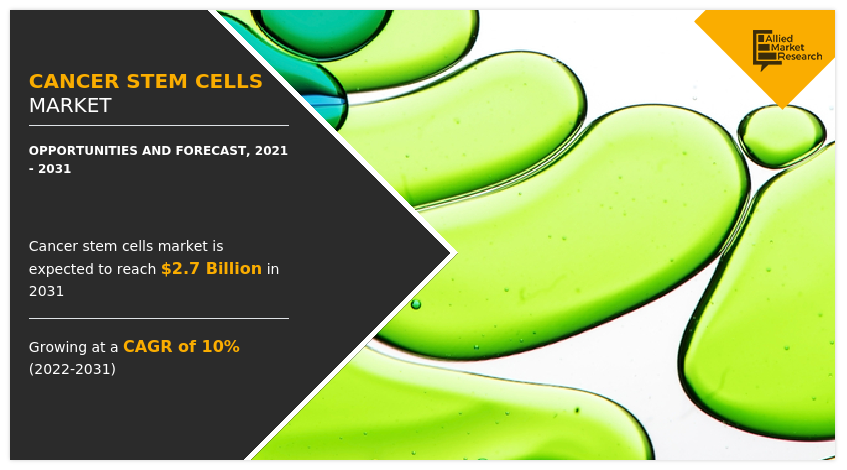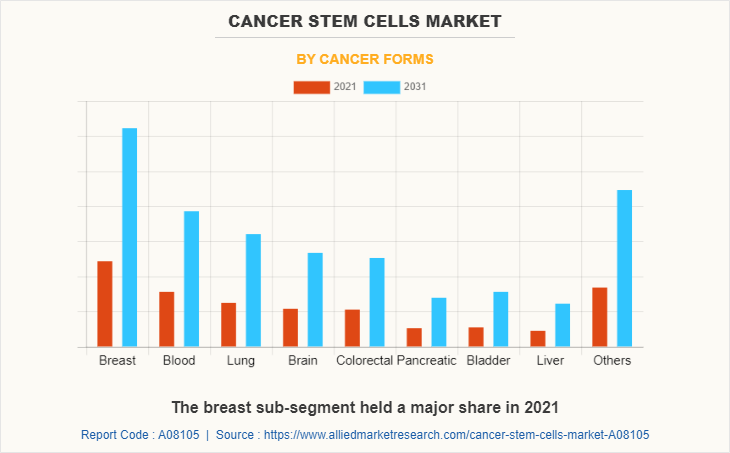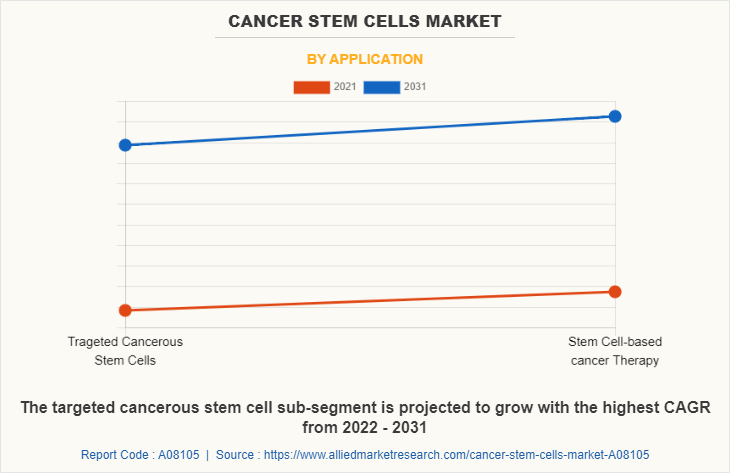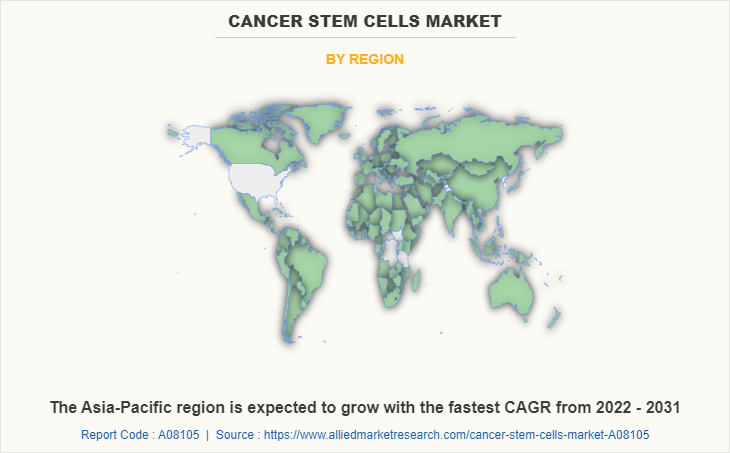Cancer Stem Cells Market Research, 2031
The global cancer stem cells market size was $1.1 billion in 2021 and is projected to reach $2.7 billion by 2031, growing at a CAGR of 10% from 2022 to 2031. Cancer stem cells (CSCs) are small subpopulations of cells that are capable of self-renewal, differentiation, and tumorigenicity, as well as they, give rise to every type of cell seen in a specific cancer sample.

Cancer stem cells are unique in that they can differentiate into several lineages and have the potential to multiply greatly, among other things. The majority of tissues, including the brain, prostate, lungs, and other tissues, include these cells. Cancer therapy benefits greatly from the use of cancer stem cells. It's critical to comprehend the numerous relationships between stem cells and cancer. For instance, stem cell technology focuses on fighting cancer-causing disorders while also providing vital information regarding the cause of the disease.
Major factors driving cancer stem cells market include an increase in R&D activities that facilitates the development of medications to treat cancer, which is the leading cause of death globally. Additionally, the need for a safe and efficient treatment that will completely destroy cancer cells in the body while reducing the patient's risk of relapse or metastasis has increased due to the rising incidence of cancer worldwide. As a result, funding for new treatment technology and cancer-related research studies is increasing rapidly. These factors are anticipated to fuel the cancer stem cell market growth in the forecasted time period.
The clinical procedures involved in stem cell transplantation are critical and involve high risk, such as the radiation therapy that is used to diagnose different types of cancer. For instance, when aggressive tumors are treated with very high doses of radiation therapy, the blood-forming and leukocyte cells are either completely or partially destroyed. In such cases, the patients require an infusion of hematopoietic stem cell transplant, either allogeneic or autologous. Such medical procedures are very costly due to which the middle-class and lower-class sectors have less awareness and access to such therapies. These factors are anticipated to hamper the growth of the cancer stem cell market in forecast time period.
Market Dynamics
According to the estimates provided by the World Health Organization (WHO), cancer accounted for about 10 million deaths in 2020, making it one of the top causes of mortality. The demand for efficient medicines and transplantation caused by the rise in cancer types like lymphoma, leukemia, osteopetrosis, and other diseases is leading to extensive research in the cancer stem cells. The market for cancer stem cells is expanding as a result of growing investment possibilities provided by the government, top biomedical businesses, and clinical R&D activities conducted globally. Leading pharmaceutical and biomedical businesses are working on innovating new cancer therapy for the treatment of cancer using cancer stem cell. Stem cell-based technology can provide several opportunities in field of cancer therapy. Stem cells can reach solid tumors and micro metastatic lesions to administer anti-tumor agents. In order to avoid the short half-lives of standard antitumor medicines, stem cells can be engineered to express a variety of antitumor agents. The mechanism of stem cells may enhance stem cell-based regeneration medicine as well as anticancer methods that will ultimately play important role in the widespread clinical use of stem cells therapy.
The industry players are investing a lot of efforts in the research and development of smart and unique strategies to sustain their growth in the market. These strategies include product launches, mergers & acquisitions, collaborations, partnerships, and refurbishing of existing technology. On June 8, 2022, BlueRock Therapeutics LP, a biopharmaceutical firm and wholly-owned subsidiary of Bayer AG, announced the establishment of a new cell treatment innovation site on Bayer's campus in Berlin, Germany. While working independently, the BlueRock team will take advantage of the knowledge held by multiple Bayer departments in order to expand and expedite the company's clinical studies to Europe.
The key players profiled in this report include AdnaGen GmbH, Advanced Cell Diagnostics, Inc., AVIVA Biosciences Corporation, Celula, Inc., Epic Sciences, Inc., Fluxion Biosciences, Inc., Rarecells USA, Inc. and Silicon Biosystems, S.p.A.
Segment Overview
The global cancer stem cells market is segmented on the basis of cancer forms, application, and region. By cancer forms, the market is sub-segmented into breast, blood, lung, brain, colorectal, pancreatic, bladder, liver, and others. By application, the market is classified into targeted cancerous stem cells, stem cell-based cancer therapy. By region, the market is analyzed across North America, Europe, Asia-Pacific, and LAMEA. The cancer stem cells market is segmented into Cancer Forms and Application.

By Cancer Forms
By cancer forms, the breast cancer sub-segment dominated the cancer stem cells market in 2021. Breast cancer is one of the most common diseases affecting women globally. The established risk factors for breast cancer include advancing age, reproductive variables, mammographic density, and genetic factors and family history. Numerous other elements, including dietary fat intake, alcohol consumption, exposure to solvents, and pesticides, have also been suggested as potential risk elements for breast cancer among females. The incidence of breast cancer is steadily rising in most industrialized nations and in communities that have recently undergone or are undergoing westernization such as change in lifestyles, pollution, change in diet and physical activity patterns. These are predicted to be the major factors affecting the cancer stem cells market size during the forecast period.
By cancer forms, the bladder cancer sub-segment shows the fastest growth in the cancer stem cells market in 2021. The ninth most common disease in the world is the bladder cancer. The bladder cancer is a malignant development of aberrant cells. Inhaling carcinogens from the environment, including cigarette smoke, volatile coal tar compounds, cooking hood smoke, and diesel exhaust can lead to bladder cancer. The main known cause of bladder cancer in the majority of population is smoking. About half of bladder cancer cases are caused by smoking. Smoking cessation was linked to a lower risk of bladder cancer, just like it was for many other malignancies caused by smoking. These factors are anticipated to fuel the growth of cancer cell stems market for bladder cancer during the forecast period time.

By Application
By application, the stem cell-based cancer therapy sub-segment dominated the global cancer stem cells market share in 2021. Traditional surgical or chemo radiotherapeutic methods typically cannot eradicate metastatic cancer cells, and disease recurrence is very common in such cases, after the treatment. On the other hand, stem cell-based therapies are becoming more and more promising for the treatment of cancer. By focusing on both metastatic tumor foci and primary stem cells, novel delivery strategies can be developed. In preclinical animal models, stem cells modified to persistently express different cytotoxic drugs reduce tumor sizes and lengthen longevity have shown positive results. Additionally, they have been used as viral and nanoparticle carriers to improve primary therapeutic efficacies and lessen side effects of treatment. Additionally, stem cells can be used in cancer stem cell-targeted therapy, immunotherapy, and applications for anticancer drug screening.

By Region
By region, North America dominated the global cancer market size in 2021 and is projected to remain the fastest-growing sub-segment during the forecast period. North America has well-established healthcare and medical research facilities. The United States is one of the top locations for cutting-edge research and development in cancer stem cells and has a sizably large budget. The existence of numerous renowned biomedical research institutions and their active involvement in the development of novel therapies and transplants are projected to support the market's expected revenue growth in this area. The availability of cutting-edge research infrastructure, the involvement of numerous important medical institutes, the rise in research and development initiatives to create therapeutic options for chronic diseases, and the ease with which clinical trial approval can be granted are all expected to contribute to market growth.
COVID-19 Impact on Cancer Stem Cells Industry
- The COVID-19 pandemic had a positive impact on the cancer stem cells industry. One of the most significant advancements in stem cell research during COVID-19 has been the development of genetic engineering which alter the DNA of human and organoid technology in which the three-dimensional structure of the tissue is produced from originated stem cell.
- Experimental research is essential to providing cancer patients with the best care possible, many centers are working to modify their plans and adjust to the new environment without pausing their current work
- The adoption of hematopoietic cell transplantation (HCT) and allogeneic stem cell therapy has grown in cancer patients who have COVID-19 infections.
- During COVID-19, one of the most significant advancements in stem cell research was genetic engineering and organoid technology.
Key Benefits for Stakeholders
- The report provides exclusive and comprehensive analysis of the global cancer stem cells market trends along with the cancer stem cells market forecast.
- The report elucidates the cancer stem cells market opportunity along with key drivers, and restraints of the market. It is a compilation of detailed information, inputs from industry participants and industry experts across the value chain, and quantitative and qualitative assessment by industry analysts.
- Porter’s five forces analysis helps analyse the potential of the buyers & suppliers and the competitive scenario of the market for strategy building.
- The report entailing the cancer stem cells market analysis maps the qualitative sway of various industry factors on market segments as well as geographies.
- The data in this report aims on market dynamics, trends, and developments affecting the cancer stem cells market growth.
Cancer Stem Cells Market Report Highlights
| Aspects | Details |
| By Cancer Forms |
|
| By Application |
|
| By Region |
|
| Key Market Players | Miltenyi Biotec, FUJIFILM Irvine Scientific., Stemline Therapeutics, Inc., Bionomics, Lineage Cell Therapeutics, Inc., Thermo Fisher Scientific Inc., AbbVie Inc., MacroGenics, Inc., Merck KGaA, STEMCELL Technologies Inc. |
Analyst Review
Increase in the prevalence rate due to smoking, unhealthy lifestyle, and addiction to alcoholism results in an increase in the patient count of cancerous patients. In addition, as people are becoming aware of cancer, there is a decrease in its mortality rate. Currently, numerous types of cancer are coming across globally and its rate is increasing day by day. Cancer stem cell-based therapies provide better solutions to healthcare professionals for treatment of the cancer patients. However, the high cost of stem cell therapy is not affordable to a middle-class family and complicated clinical procedures are the key factors expected to hamper the market growth during the forecast period. On the contrary, the rapid occurrence of cancer disease and the rise in use of stem cell therapy are factors anticipated to provide remunerative opportunities for key players to maintain the pace of the cancer stem cell market in the upcoming years.
Among the analyzed regions, North America is expected to account for the highest revenue in the market by the end of 2031, followed by Asia-Pacific, Europe, and LAMEA. Active participation in research and easy approval of clinical trials are the key factors responsible for the leading position of North America in the global cancer stem cell market.
Self-renewal is an important feature of stem cells in normal tissue and malignant tissues. Stem cell transplant is a process that repairs stem cells that help to form blood in persons destroyed due to high dosages of radiation therapy or chemotherapy that are used to treat certain cancers, which is estimated to generate excellent opportunities in the cancer stem cell market
The major growth strategies adopted by cancer stem cell market players are merger & acquisition and advanced product development.
North America will provide more business opportunities for the global cancer stem cell market in the future.
AdnaGen GmbH, Advanced Cell Diagnostics, Inc., and AVIVA Biosciences Corporation are major players in the cancer stem cell market.
The breast cancer sub-segment of the cancer form acquired the maximum share of the global cancer stem cell market in 2021.
The report provides an extensive qualitative and quantitative analysis of the current trends and future estimations of the global cancer stem cell market from 2021 to 2031 to determine the prevailing opportunities.
The use of cancer stem cell in the recurrence of tumors and drug resistance development is estimated to drive the adoption of cancer stem cell.
The rising application of cancer stem cell in the treatment of cancer in therapeutics and medicine is anticipated to boost the cancer stem cell market in the upcoming years.
Loading Table Of Content...


